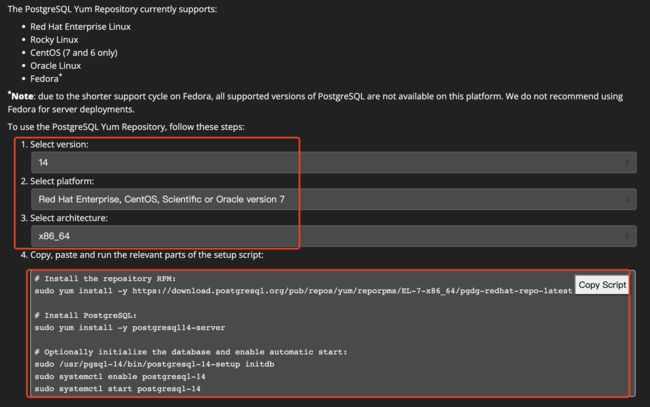Centos7下安装PostgreSQL14及其基本命令使用
MySQL关系型数据库目前算是互联网公司使用最多的。前两天看到一个推文,相对比国内使用MySQL,PostgreSQL在国内的普及貌似不高?国外像网络电话公司Skype公司等在大量使用PostgreSQL
作为互联网从业者,保持学习是必须的。开始学习PostgreSQL作为技术储备
PostgreSQL 二进制安装
Centos下二进制安装一般是借助于 YUM 来安装。在 PostgreSQL的官网选定版本和操作系统之后,会自动生成YUM安装脚本
对应的页面地址为 https://www.postgresql.org/download/linux/redhat/
选择对应的 PostgreSQL版本、操作系统和架构,下面就生成了 YUM安装命令
安装命令
# 先安装PostgreSQL的YUM源
sudo yum install -y https://download.postgresql.org/pub/repos/yum/reporpms/EL-7-x86_64/pgdg-redhat-repo-latest.noarch.rpm
# 安装server
sudo yum install -y postgresql14-server
# 先必须进行初始化
sudo /usr/pgsql-14/bin/postgresql-14-setup initdb
# 然后可以选择性的开启 开机自启动
sudo systemctl enable postgresql-14
# 启动服务
sudo systemctl start postgresql-14
但是有个问题
PostgreSQL 初始化数据库之后,默认的数据目录是在
/var/lib/pgsql,但是该目录是在根分区下,一般建议放到独立的数据目录下
所以这里进行如下操作
# 新增 数据磁盘目录
mkdir /data/databases
# 停止数据库
systemctl stop postgresql-14
# 移动原始数据目录
mv /var/lib/pgsql /data/databases/
# 创建软连
cd /var/lib && ln -s /data/databases/pgsql pgsql
# 然后启动服务
systemctl start postgresql-14
最后验证安装是否成功
# 切换到 postgres 用户(yum安装时自动生成)
[root@test-demo-01-vm]$ su - postgres
# 直接输入 psql 回车, 输出 psql (14.6) 就代表安装成功
[postgres@test-demo-01-vm]$ psql
psql (14.6)
Type "help" for help.
# \l 列举目前实例中的所有数据库,类似mysql中的 show databases ;
postgres=# \l
List of databases
Name | Owner | Encoding | Collate | Ctype | Access privileges
-----------+----------+----------+-------------+-------------+-----------------------
postgres | postgres | UTF8 | en_US.UTF-8 | en_US.UTF-8 |
template0 | postgres | UTF8 | en_US.UTF-8 | en_US.UTF-8 | =c/postgres +
| | | | | postgres=CTc/postgres
template1 | postgres | UTF8 | en_US.UTF-8 | en_US.UTF-8 | =c/postgres +
| | | | | postgres=CTc/postgres
(3 rows)
postgres=# \du
List of roles
Role name | Attributes | Member of
-----------+------------------------------------------------------------+-----------
postgres | Superuser, Create role, Create DB, Replication, Bypass RLS | {}
postgres=# \dg
List of roles
Role name | Attributes | Member of
-----------+------------------------------------------------------------+-----------
postgres | Superuser, Create role, Create DB, Replication, Bypass RLS | {}
PostgreSQL 说明
1、从 \l 列举出来的数据库清单中,看到有三个数据库
-
PostgreSQL中默认有两个特殊的数据库,template0/template1 模板数据库
就是说可以在这两个数据库中新增一些表、视图等,然后创建数据库的时候可以指定从那个模板数据库来
克隆,这样新增的数据库就会有对应的模板数据库包括的表或者视图等-
创建数据库不指定模板数据库的时候,默认从
template1克隆 -
template0 是默认
最简化的数据库,它不能连接到该库,也不能对其就行修改,要保持它的"干净" -
使用 template1 模板库建库时不可指定新的 encoding 和 locale,而 template0 可以
-
默认这两个模板数据库都不可以被删除
-
-
postgres 库是默认创建的非模板数据库,它是属于 postgres 数据库用户, 在Centos服务器还有个 postgres Linux用户
1、所以这里注意这三个
postgres的区别2、Linux下切换到postgres用户直接使用
客户端工具psql连接时不加参数登录,其实就是使用 postgres 数据库用户登录3、
postgres数据库用户是默认的超级用户
2、关于 PostgreSQL中的用户和角色
在PostgreSQL 中使用角色 来管理权限,可以把一系列权限分配给角色,当然也可以把权限分配给用户。
所以从这个角度理解的话,Postgresql 用户和角色 是一回事,用户也是角色。 从上面的\du 或者 \dg 的结果就能知道
PostgreSQL中的所有命令都是
\开头
PostgreSQL 基本命令
1、数据库操作
列举数据库\l、连接数据库 \c dbname
template1=# create database colinspace ;
CREATE DATABASE
template1=# \l
List of databases
Name | Owner | Encoding | Collate | Ctype | Access privileges
------------+----------+----------+-------------+-------------+-----------------------
colinspace | postgres | UTF8 | en_US.UTF-8 | en_US.UTF-8 |
postgres | postgres | UTF8 | en_US.UTF-8 | en_US.UTF-8 |
template0 | postgres | UTF8 | en_US.UTF-8 | en_US.UTF-8 | =c/postgres +
| | | | | postgres=CTc/postgres
template1 | postgres | UTF8 | en_US.UTF-8 | en_US.UTF-8 | =c/postgres +
| | | | | postgres=CTc/postgres
(4 rows)
template1=# \c colinspace
You are now connected to database "colinspace" as user "postgres".
2、表操作
- 列举数据库下的表
\d - 查询具体表结构信息
\d tablename - 查询表的索引信息
\d table_index_name
colinspace=# \d
Did not find any relations.
colinspace=# create table temp_app(id int not null primary key, name varchar(32) not null) ;
CREATE TABLE
colinspace=# \d
List of relations
Schema | Name | Type | Owner
--------+----------+-------+----------
public | temp_app | table | postgres
(1 row)
colinspace=# \d temp_app
Table "public.temp_app"
Column | Type | Collation | Nullable | Default
--------+-----------------------+-----------+----------+---------
id | integer | | not null |
name | character varying(32) | | not null |
Indexes:
"temp_app_pkey" PRIMARY KEY, btree (id)
colinspace=# \d temp_app_pkey
Index "public.temp_app_pkey"
Column | Type | Key? | Definition
--------+---------+------+------------
id | integer | yes | id
primary key, btree, for table "public.temp_app"
此外
- 支持通配符
*和?,查询满足规则的表或者索引等 \d+详细更加详细的表信息\dt只显示匹配的表\di只显示索引\ds只显示序列\dv只显示视图\df只显示函数\dn列出所有的 schema 模式\db列出所有的表空间\du或者\dg列出数据库中的所有角色后者用户\dp或者\z显示表的权限分配情况
3、特殊命令
3.1、\timing on/off 显示和关闭 SQL 已执行的时间
colinspace=# \timing on
Timing is on.
colinspace=# select * from temp_app ;
id | name
----+------
(0 rows)
Time: 0.729 ms
colinspace=# \timing off
Timing is off.
3.2、\encoding utf8/gbk 等设置客户端的字符编码
3.3、\pset border 0/1/2 设置输出的格式
- 0 表示输出的内容无边框
- 1 表示输出的边框只在内部 (默认行为)
- 2 表示内外都有边框
colinspace=# \pset border 0
Border style is 0.
colinspace=# \d
List of relations
Schema Name Type Owner
------ -------- ----- --------
public temp_app table postgres
(1 row)
colinspace=# \pset border 1
Border style is 1.
colinspace=# \d
List of relations
Schema | Name | Type | Owner
--------+----------+-------+----------
public | temp_app | table | postgres
(1 row)
colinspace=# \pset border 2
Border style is 2.
colinspace=# \d
List of relations
+--------+----------+-------+----------+
| Schema | Name | Type | Owner |
+--------+----------+-------+----------+
| public | temp_app | table | postgres |
+--------+----------+-------+----------+
(1 row)
3.4、\x 类似MySQL的在命令之后添加\G
3.5、\i filename 执行存储在外部文件中的sql文件或者命令, 参数是只要文件名,不带后缀
当然想要查看更多的命令及其用法,可以使用
\?
如果有在学PostgreSQL的,可以一起交流学习~
原文连接 Centos7下安装PostgreSQL14及其基本命令使用
